| کد مقاله | کد نشریه | سال انتشار | مقاله انگلیسی | نسخه تمام متن |
|---|---|---|---|---|
| 1055850 | 1485279 | 2014 | 6 صفحه PDF | دانلود رایگان |
• Biochars derived from three various feedstocks were used for Cr and As removal.
• The adsorption results were compared to those when a sandy loam soil was used.
• Biochar from municipal solid wastes was most efficient in removing Cr(VI) and As(V).
• Soil could not strongly retain metal anions as compared to biochars.
• Biochar amendment to soil could enhance its ability to restrain heavy metals.
Biochars derived from rice husk, the organic fraction of municipal solid wastes and sewage sludge, as well as a sandy loam soil, were used as adsorbents for As(V), Cr(III) and Cr(VI) removal from aqueous solutions. The kinetic study showed that sorption can be well described by the pseudo-second order kinetic model, while simulation of sorption isotherms gave better fit for the Freundlich model. The materials examined removed more than 95% of the initial Cr(III). However, removal rates for As(V) and Cr(VI) anions were significantly lower. Biochar derived from sewage sludge was efficient in removing 89% of Cr(VI) and 53% of As(V). Its ash high Fe2O3 content may have enhanced metal adsorption via precipitation. Soil was the most effective material for the removal of As(V), yet it could not strongly retain metal anions compared to biochars, as a significant amount of the adsorbed metal was released during desorption experiments.
Journal: Journal of Environmental Management - Volume 133, 15 January 2014, Pages 309–314
